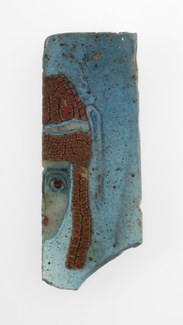Fragment of Inlay Depicting a Theater Mask

Glass production flourished during the Ptolemies’s reign: the Macedonian kings introduced to Egypt new glass vessels and glass decorations whose shapes, motifs, and techniques originated in the ancient regions of the Mediterranean. The fragments on display, in their wide range of forms and colors, illustrate the infinite variants that could easily be produced by adopting the Greek glass-making technique known as core-forming, which allowed serial reproduction of the same motif almost indefinitely. The glassmaker began with a group of thin molten-glass rods of different colors. He combined them into a cane, arranging the various rods next to each other to create a design that would be visible when a cross-section of the cane was cut. To make this plaque the cane was shaped to design one half of the masque. The complete plaque was thus formed by joining two identical slices from the same cane with one slice reversed.
E. M. Stern, B. Schlick-Nolte. Early Glass of the Ancient World: 1600 B.C. - A.D. 50. Ernesto Wolf Collection. Verlag Gerd Hatje, Ostfildern, 1994.